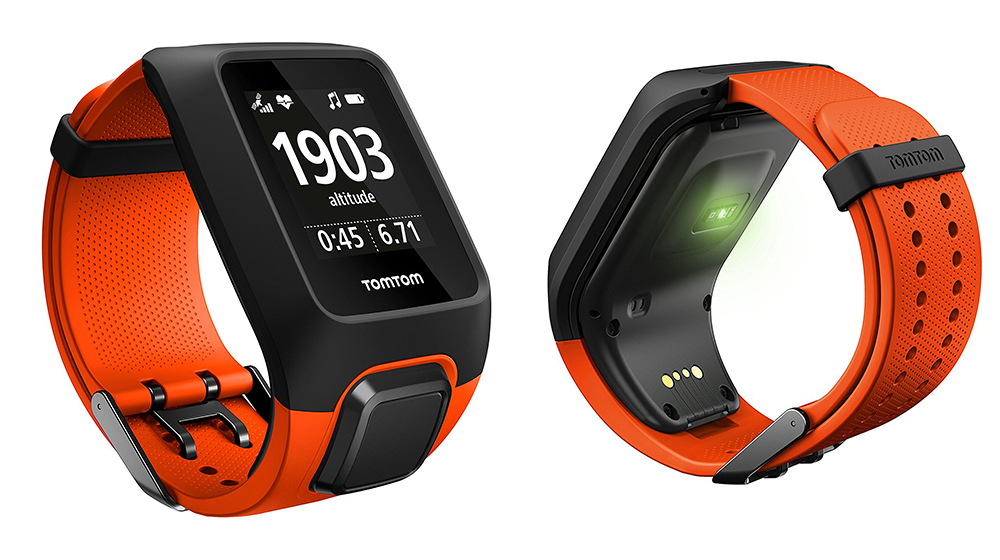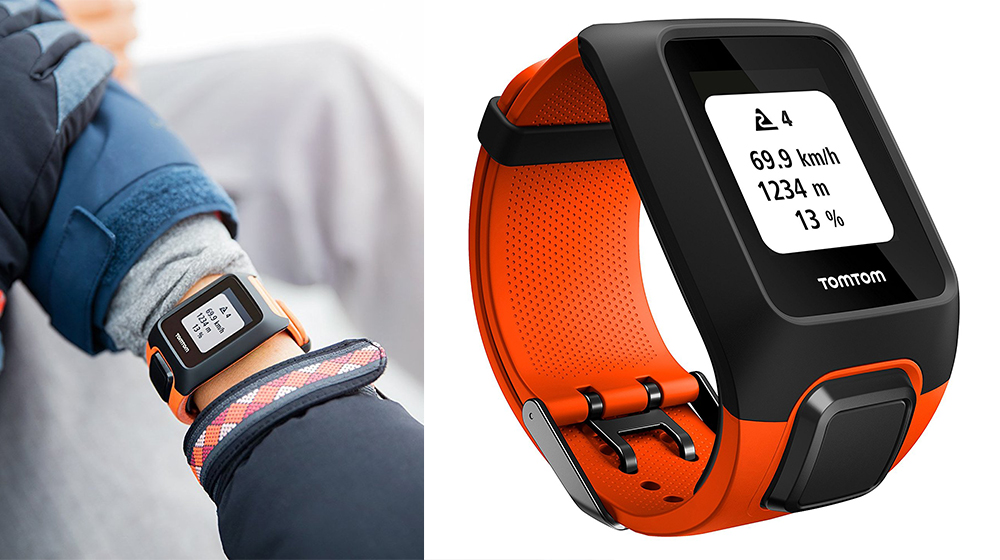Our Verdict
Things we liked Extensive multi-sport support: running, cycling (it pairs with cycling sensors for cadence tracking), swimming, hiking, skiing and snowboarding (with automatic ski lift detection), as well as all-day activity tracking The GPS locks in fast and the hiking mode tweaks things so the battery can last all day You can upload routes to follow the device, or wing it and use the digital breadcrumb trail to find your way back home The clear and easy-to-read display has a simple backlight trigger for nighttime, and is controlled by an elegant four-way navigation system It’s packed with hardware and features: integrated heart rate monitor, barometric altimeter for 3D distance tracking, compass and built-in memory for streaming music to Bluetooth headphones The Adventurer will export data to a multitude of third-party platform and apps Things we didn’t like It’s not an ideal everyday watch The sleep-tracking features are a bit pointless since it’s too bulky to wear overnight If you don’t ski or hike regularly, the TomTom Spark 3 may be a better option
You can trust Coach
TomTom Adventurer In-Depth
While there’s no shortage of GPS sports watches out there, there are only a few that cater to hardcore or extreme athletes. The Garmin Fenix and Suunto Ambit ranges have dominated, but the Adventurer challenges these two with a good range of features above and beyond what most GPS sports watches can offer. The Adventurer sits at the top of the TomTom range with some unique features that you won’t find on the Runner (or Spark) watches.
Using the TomTom Adventurer as a heart rate monitor

The TomTom Adventurer features an optical heart rate monitor, a more convenient alternative to chest-strap monitors, although optical versions don’t react as quickly to changes in heart rate – like when you’re running intensive intervals.
However, for more steady-state activities, an optical HRM will do just fine, and the one built into the Adventurer proved to be pretty accurate compared with a chest strap over a 10km run.
If you do need to run intervals regularly, you can also pair a Bluetooth chest-strap heart rate monitor with the Adventurer. TomTom’s goes for £59.99 and it will play nice with others.
Using the TomTom Adventurer for running
The TomTom Adventurer delivers everything that the cheaper TomTom Spark 3 delivers when it comes to running, logging speed, distance, pace, time, elevation and calories burned.
You can also set the Adventurer to auto-lap based on distance or time to track splits in real time, as well as defining zones based on heart rate, pace or speed – something that will come in handy for many training plans. There’s the option to create interval workouts, too, again based on time or distance.
The built-in GPS will track your route as you run and overlay it on a map when you sync with the app like any other GPS running watch, but it will also leave you a trail of digital breadcrumbs (in the “Hansel and Gretel” sense) as you run.
Sign up for workout ideas, training advice, reviews of the latest gear and more.
This feature is primarily aimed at trail running and, speaking as someone who has got lost in the woods a few times, it’s a useful addition.
Routes can also be uploaded to the Adventurer in the form of .gpx files. That means you can plan a run, then follow it on the watch. You can also save completed runs as trails, so if you discover a great route by accident you can easily follow it again.
If you tend to run at night you’ll still be able to check your progress on the Adventurer without having to fiddle with any buttons – simply cover the face of the watch with your hand to trigger the backlight.
You won’t have to run in silence either since, like TomTom’s Spark and Runner watches, the Adventurer has 3GB of storage built in for music files, which will stream wirelessly to Bluetooth headphones – you can also get performance updates while you’re listening. Given that smartphones are getting bigger and bigger, not having to carry one with you when running is a real bonus.
Using the TomTom Adventurer for hiking
It’s an oversimplification to say that hiking is essentially trail running at a slower pace. For one, you’re likely to be out for longer so battery life takes on greater importance. TomTom has reduced the frequency of GPS tracking when the Adventurer is in hiking mode to save juice, allowing for 24 hours of hiking without stopping to recharge.
It’s also likely that you’ll be encountering broader changes in elevation during your hike, which the barometric altimeter will be able to track with far greater accuracy than the GPS alone would. The Adventurer also uses this tech to measure 3D distance – going up adds distance after all.
The compass that TomTom has also integrated is an undoubtedly useful feature when hiking, too.
Using the TomTom Adventurer for skiing
If 24-hour hikes aren’t enough for you, the Adventurer will also track your antics on the slopes. There are both ski and snowboard settings built into the Adventurer, but they measure the same things.
While you’re nailing your favourite black run the Adventurer will be tracking your heart rate, distance, descent, speed, time and run count. When you reach the bottom the Adventurer will automatically detect when you jump on the ski lift, and display the key stats from your last run – maximum speed, descent and maximum gradient.

Unfortunately I haven’t managed to test the Adventurer’s alpine credentials yet, but we’ll update this review after my next snowboarding trip.
Using the TomTom Adventurer for cycling
With its integrated GPS the TomTom Adventurer can track speed, distance and pace while cycling, essentially making it a decent wrist-based cycle computer. The integrated heart rate monitor will also come in handy, although hardcore cyclists might prefer to use a chest strap.
The Adventurer can also pair with a Bluetooth cadence sensor, delivering almost all the data that a cyclist needs. It doesn’t measure power output as there’s no option to pair with a power meter, but anyone coughing up hundreds or even thousands of pounds for a power meter will undoubtedly invest in a dedicated cycle computer.
As with running, the cycling setting on the Adventurer allows for interval training based on time or distance, and custom training zones based on speed, pace, heart rate and cadence (assuming you have a cadence sensor paired).
That barometric altimeter will give you a very accurate indication of elevation change throughout your ride, too. As any dedicated cyclist know, it’s all about the climbing.
Using the TomTom Adventurer for swimming
The TomTom Adventurer is waterproof to 40m and will count lengths in the pool – the default pool length is 25m, but you can enter a custom length.
As with other pursuits, the Adventurer can auto-lap or configure interval sessions based on time and distance. Goals can be set based on time, distance or calories burned, but bear in mind that the heart rate monitor will not function while you’re in the water.
It’s not as swim-focused as, say, the Garmin Forerunner 920XT, but the Adventurer will still deliver you a decent amount of data at the end of your session.
RECOMMENDED: The Best Swimming Watches
Using the TomTom Adventurer for activity tracking
The Adventurer will log your every step and use that to estimate distance travelled and calories burned. Pressing the four-way control button to the left will display your step count for the day, while pressing it left again will display your count for the week.
If you’d rather not base your daily and weekly goals on steps, you can switch to calories, distance covered or even active time. It’s always good to see a bit of customisation on offer, since one size rarely fits all.
Conspicuous by its absence is any form of altimeter functionality in the fitness-tracking department, which is odd considering that the Adventurer has a highly accurate barometric altimeter built into it.
Even so, if you’re looking for a feature-packed GPS sports watch that can also double as your daily fitness tracker, the Adventurer is up to the task.
Using the TomTom Adventurer for calorie counting
If you use the Adventurer as your daily fitness tracker it will count the calories you burn throughout the day. If calories are your key metric, you can even make them your daily goal and set the bar as high as you like.
You can also pair the TomTom MySports app with MyFitnessPal so you can log all your food throughout the day and get a dynamic calorie count, which is handy if you’re trying to lose weight.
Using the TomTom Adventurer as a sleep tracker
Your sleep will be tracked automatically if you choose to wear the Adventurer overnight, but I wouldn’t choose to do so – it’s a little bulky to be worn while you sleep.
For sleep tracking to really work you need a device that’s small and light enough to be comfortable overnight, as well as an extended battery life. That’s why tiny devices with batteries that last for months like the Misfit Ray make the best sleep trackers.
How often am I going to have to charge it?
That depends on how you use it. If you were to use it primarily as a fitness tracker without making use of the GPS, you’d get around three weeks of use.
But this is aimed at athletes who will want to use the GPS as much as possible, in which case you’ll be looking at around 11 hours.
And if you go all-out and use the GPS, heart rate monitor and music streaming, the battery will last around five hours. If you run with music three times a week, you’ll probably have to charge the Adventurer every five days or so.
The TomTom app
The TomTom MySports app has definitely improved over the past year, but it’s still far from the best platform out there. Still, that doesn’t really matter, since TomTom will partner with most fitness platforms such as Nike+, Strava or Runkeeper, and you can automatically sync your data with as many of them as you like.
RECOMMENDED: The Best Health And Fitness Apps
However, while wireless syncing with the TomTom MySports smartphone app has improved, it’s still quite a slow and clunky affair. That’s not to say it doesn’t work – it’s just not as slick an experience as you’d find elsewhere.
Where can I wear it without people laughing at me?
The bright orange strap that ships with the Adventurer isn’t exactly subtle and it’s also quite a bulky affair compared with the Runner’s strap, but since the Adventurer is exactly the same size as the Runner, you can swap straps and make it a bit less obtrusive.
If you’re someone who’s happy to wear a GPS sports watch as your everyday timepiece, the Adventurer – in the right strap – will look no worse than any other. Just don’t go expecting it to give a Rolex Submariner a run for its money in the style stakes.
Buy on tomtom.com (£269.99) | Buy on amazon.co.uk (£260.40 at time of writing)
Should I consider buying something else?
The most obvious competitors are the Garmin Fenix and Suunto Ambit ranges, but the simplicity and ease of navigation offered by the TomTom Adventurer – not to mention its comparatively small form factor – will make it a more attractive option for some.
Bizarrely, though, it’s not another brand that poses the biggest threat to the Adventurer, it’s TomTom’s own Spark 3. Unless you’re hitting the ski slopes regularly and heading out for hiking weekends whenever possible, the Spark 3 Cardio + Music (£219.99) will provide much of the same functionality for significantly less outlay.
However, if you’re chasing the snow and exploring new hiking trails at every opportunity, the Adventurer is certainly worth considering.

